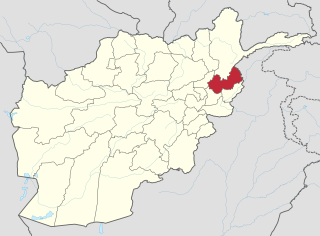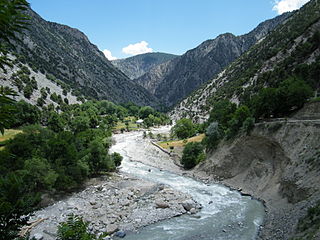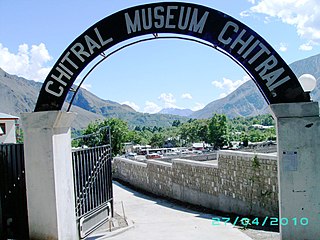
Kāfiristān, or Kāfirstān, is a historical region that covered present-day Nuristan Province in Afghanistan and its surroundings. This historic region lies on, and mainly comprises, the basins of the rivers Alingar, Pech (Kamah), Landai Sin river and Kunar, and the intervening mountain ranges. It is bounded by the main range of the Hindu Kush on the north, Pakistan's Chitral District to the east, the Kunar Valley in the south and the Alishang River in the west.

The Nuristani languages, also known as Kafiri languages, are one of the three groups within the Indo-Iranian language family, alongside the much larger Indo-Aryan and Iranian groups. They have approximately 130,000 speakers primarily in eastern Afghanistan and a few adjacent valleys in Khyber Pakhtunkhwa's Chitral District, Pakistan. The region inhabited by the Nuristanis is located in the southern Hindu Kush mountains, and is drained by the Alingar River in the west, the Pech River in the center, and the Landai Sin and Kunar rivers in the east. The languages were previously often grouped with Indo-Aryan or Iranian until they were finally classified as forming a third branch in Indo-Iranian.

Chitral District is the largest district in the Khyber-Pakhtunkhwa province of Pakistan, covering an area of 14,850 km², before splitting into Upper Chitral District and Lower Chitral District in 2018. Part of the Malakand Division, it is the northernmost district of Pakistan. It shares a border with Gilgit-Baltistan to the east, with Kunar, Badakshan and Nuristan provinces of Afghanistan to the north and west, and with the Khyber-Pakhtunkhwa districts of Swat and Dir to the south. A narrow strip of Wakhan Corridor separates Chitral from Tajikistan in the north.

Khowar or Chitrali, is an Indo-Aryan language primarily spoken in Chitral and surrounding areas in Pakistan.

Kalasha is an Indo-Aryan language spoken by the Kalash people, in the Chitral District of Khyber Pakhtunkhwa province of Pakistan. There are an estimated 4,100 speakers of Kalasha. It is an endangered language and there is an ongoing language shift to Khowar.
Mara or Mrityu Devi is a Sanskrit word meaning "death" or any personification thereof. In Hinduism, Mara is the goddess of death and offerings would be placed at her altar. Though much less popular, some sects of worship do exist in India. Her counterpart in Latvian mythology is Māra.

The Peshawar Museum is a museum located in Peshawar, capital of Pakistan's Khyber Pakhtunkhwa province. The Peshawar Museum is notable for its collection of Buddhist artwork dating from the ancient Gandhara region.
Waigali, also known as Nuristani Kalasha, is a language spoken by about 10,000 Nuristani people of the Waigal Valley in the Nuristan Province of Afghanistan. The native name is Kalaṣa-alâ 'Kalasha-language'. "Waigali" refers to the dialect of the Väy people of the upper part of the Waigal Valley, centered on the town of Waigal, which is distinct from the dialect of the Čima-Nišei people who inhabit the lower valley. The word 'Kalasha' is the native ethnonym for all the speakers of the southern Nuristani languages.

The Kho or Chitrali people, are an Indo-Aryan ethnolinguistic group native to the Chitral District in Khyber Pakhtunkhwa and the Gupis-Yasin and Ghizer districts in Gilgit-Baltistan of Pakistan. They speak an Indo-Aryan language called Khowar.

The Kalasha, or Kalash, are an Indo-Aryan indigenous people residing in the Chitral District of Khyber-Pakhtunkhwa province of Pakistan.
Tach Sharakat Kalash belongs to an endangered Indigenous culture and language community Kalasha living in the wilderness of Hindu Kush Mountains in the Chitral district of Pakistan. Kalasha are the last remaining pagan tribe numbering 4000 people speaking the ancient Indo-Aryan language Kalasha-mondr. They practice a polytheistic ancestral belief system and Pre-Islamic culture dating back to 3000 B.C.

Bumburet is the largest valley of Kalasha Desh in Lower Chitral District, Khyber Pakhtunkhwa the province of Pakistan.

The Kalasha Valleys are valleys in Chitral District in northern Pakistan. The valleys are surrounded by the Hindu Kush mountain range.

Rumbur is one of the three Kalasha valleys situated in Chitral District, Khyber Pakhtunkhwa, Pakistan.
Chilam Joshi Festival is a festival celebrated by the Kalash people, living in the Chitral District of Khyber Pakhtunkhwa province in Pakistan. It marks the commencement of spring within the Kalasha community and is celebrated from the 13th to the 16th of May each year.
Maureen Patricia Lines, locally known as Bibi Dow of Kalash, was a British author, photographer, social worker and environmentalist who was known for her work on the Kalasha people.
Dir Museum, also known as Chakdara Museum, is located in Chakdara, Lower Dir District, in the Khyber Pakhtunkhwa province of Pakistan. The museum offers a fine and unique collection of Gandharan Art.

Chitral Museum is a museum located in Chitral District, Khyber Pakhtunkhwa, Pakistan. It was established on 8 July 2010.
Karishma Ali (c.1997) is a footballer who is the first girl from her hometown of Chitral, Khyber-Pakhtunkhwa to have represented Pakistan at national and international levels. In 2016, Ali represented Pakistan at the Jubilee Games held in Dubai and she was part of the first Pakistani women's team to participate in the Australian Football League International Cup in 2017. She is also the founder of Chitral Women's Sports Club.

Lower Chitral District is a district in Malakand Division of Khyber Pakhtunkhwa province in Pakistan.













